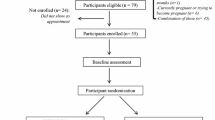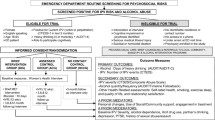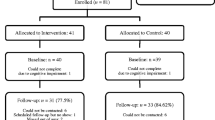Abstract
Women with histories of incarceration show high levels of risk for HIV and intimate partner violence (IPV). This randomized controlled trial with women at risk for HIV who had recent criminal justice system involvement (n = 530) evaluated two interventions based on Motivational Interviewing to reduce either HIV risk or HIV and IPV risk. Baseline and 3, 6, and 9-month follow-up assessments measured unprotected intercourse, needle sharing, and IPV. Generalized estimating equations revealed that the intervention groups had significant decreases in unprotected intercourse and needle sharing, and significantly greater reductions in the odds and incidence rates of unprotected intercourse compared to the control group. No significant differences were found in changes in IPV over time between the HIV and IPV group and the control group. Motivational Interviewing-based HIV prevention interventions delivered by county health department staff appear helpful in reducing HIV risk behavior for this population.


Similar content being viewed by others
Notes
Women who were chronically homeless or at high risk for future homelessness were excluded because of the likelihood of limited intervention effectiveness and poor subject retention. Specifically, women currently housed were excluded if they had been homeless for three or more of the past six months and could not identify a future residence. Women who were currently homeless were excluded if they had been homeless for three or more of the past six months or could not identify a specific, future residence.
ACASI was implemented to reduce costs and staff time associated with interview administration and data entry. One participant who received a baseline interviewer-administered baseline received an ACASI at one follow-up. Twelve participants who received baseline ACASI received an interviewer-administered follow-up assessment; eleven of these interviews were conducted in jail or prison where ACASI was not feasible.
References
Belcher, L., Kalichman, S., Topping, M., Smith, S., Emshoff, J., Norris, F., et al. (1998). A randomized trial of a brief HIV risk reduction counseling intervention for women. Journal of Consulting and Clinical Psychology, 66, 856–861. doi:10.1037/0022-006X.66.5.856.
Belenko, S., Langley, S., Crimmins, S., & Chapl, M. (2004). HIV risk behaviors, knowledge, and prevention education among offenders under community supervision: A hidden risk group. AIDS Education and Prevention, 16, 367–385. doi:10.1521/aeap. 16.4.367.40394.
Bourgois, P., Prince, B., & Moss, A. (2004). The everyday violence of hepatitis C among young women who inject drugs in San Francisco. Human Organization, 63, 253–265.
Cameron, A. C., & Trivedi, P. K. (1998). Regression analysis of count data. New York, NY: Cambridge University Press.
Carey, M. P., Maisto, S. A., Kalichman, S. C., Forsyth, A. D., Wright, E. M., & Johnson, B. T. (1997). Enhancing motivation to reduce the risk of HIV infection for economically disadvantaged urban women. Journal of Consulting and Clinical Psychology, 65, 531–541. doi:10.1037/0022-006X.65.4.531.
Cohen, M., Deamant, C., Barkan, S., Richardson, J., Young, M., Holman, S., et al. (2000). Domestic violence and childhood sexual abuse in HIV-infected women and women at risk for HIV. American Journal of Public Health, 90, 560–565.
Cunningham, R. M., Stiffman, A. R., Doré, P., & Earls, F. (1994). The association of physical and sexual abuse with HIV risk behaviors in adolescence and young adulthood: Implications for public health. Child Abuse & Neglect, 18, 233–245. doi:10.1016/0145-2134(94)90108-2.
Diggle, P. J., Heagerty, P. J., Liang, Y.-K., & Zeger, S. L. (2002). Analysis of longitudinal data (2nd ed.). Oxford UK: Oxford University Press.
El-Bassel, N., Gilbert, L., Krishnan, S., Schilling, R., Gaeta, T., Purpura, S., et al. (1998). Partner violence and sexual HIV-risk behaviors among women in an inner-city emergency department. Violence and Victims, 13, 377–393.
El-Bassel, N., Gilbert, L., Wu, E., Go, H., & Hill, J. (2005). Relationship between drug abuse and intimate partner violence: A longitudinal study among women receiving methadone. American Journal of Public Health, 95, 465–470. doi:10.2105/AJPH.2003.023200.
Gielen, A. C., Ghandour, R. M., Burke, J. G., Mahoney, P., McDonnell, K. A., & O’Campo, P. (2007). HIV/AIDS and intimate partner violence: Intersecting women’s health issues in the United States. Trauma, Violence & Abuse, 8, 178–198. doi:10.1177/1524838007301476.
Gielen, A. C., McDonnell, K. A., & O’Campo, P. J. (2002). Intimate partner violence, HIV status, and sexual risk reduction. AIDS and Behavior, 6, 107–116. doi:10.1023/A:1015494513192.
Gilbert, L., El-Bassel, N., Manuel, J., Wu, E., Go, H., Golder, S., et al. (2006). An integrated relapse prevention and relationship safety intervention for women on methadone: Testing short-term effects on intimate partner violence and substance use. Violence and Victims, 21, 657–672. doi:10.1891/vivi.21.5.657.
Greenfeld, L. A., & Snell, T. L. (2000). Women offenders. U.S. Department of Justice.
Grella, C. E., & Greenwell, L. (2007). Treatment needs and completion of community-based aftercare among substance-abusing women offenders. Women’s Health Issues, 17, 244–255. doi:10.1016/j.whi.2006.11.005.
Hammett, T. M., & Drachman-Jones, A. (2006). HIV/AIDS, sexually transmitted diseases, and incarceration among women: National and southern perspectives. Sexually Transmitted Diseases, 33, S17–S22. doi:10.1097/01.olq.0000218852.83584.7f.
Hammett, T. M., Harmon, M. P., & Rhodes, W. (2002). The burden of infectious disease among inmates of and releasees from US correctional facilities, 1997. American Journal of Public Health, 92, 1789–1794.
Hammett, T. M., Roberts, C., & Kennedy, S. (2001). Health-related issues in prisoner reentry. Crime and Delinquency, 47, 390–409. doi:10.1177/0011128701047003006.
Harris, R. M., Sharps, P. W., Allen, K., Anderson, E. H., Soeken, K., & Rohatas, A. (2003). The interrelationship between violence, HIV/AIDS, and drug use in incarcerated women. The Journal of the Association of Nurses in AIDS Care, 14, 27–40. doi:10.1177/1055329002239188.
Harrison, P. M., & Beck, A. J. (2006). Prison and jail inmates at midyear 2005 (Rep. No. NCJ 213133). Washington, DC: US Department of Justice, Bureau of Justice Statistics.
Harvey, E., Strathdee, S. A., Patrick, D. M., Ofner, M., Archibald, C. P., Eades, G., et al. (1998). A qualitative investigation into an HIV outbreak among injection drug users in Vancouver, British Columbia. AIDS Care, 10, 313–321.
Kalichman, S. C., Williams, E. A., Cherry, C., Belcher, L., & Nachimson, D. (1998). Sexual coercion, domestic violence, and negotiating condom use among low-income African American women. Journal of Women’s Health, 7, 371–378.
Koblin, B., Chesney, M., Coates, T., & EXPLORE Study Team. (2004). Effects of a behavioural intervention to reduce acquisition of HIV infection among men who have sex with men: The EXPLORE randomised controlled study. Lancet, 364, 41–50. doi:10.1016/S0140-6736(04)16588-4.
Koenig, L. J., & Moore, J. (2000). Women, violence, and HIV: A critical evaluation with implications for HIV services. Maternal and Child Health Journal, 4, 103–109. doi:10.1023/A:1009570204401.
Landenburger, K. (1989). A process of entrapment in and recovery from an abusive relationship. Issues in Mental Health Nursing, 10, 209–227. doi:10.3109/01612848909140846.
Latkin, C. A., & Knowlton, A. R. (2005). Micro-social structural approaches to HIV prevention: A social ecological perspective. AIDS Care, 17, 102–113. doi:10.1080/09540120500121185.
Logan, T. K., Cole, J., & Leukefeld, C. (2002). Women, sex, and HIV: Social and contextual factors, meta-analysis of published interventions, and implications for practice and research. Psychological Bulletin, 128, 851–885. doi:10.1037/0033-2909.128.6.851.
McFarlane, J., Soeken, K., & Wiist, W. (2000). An evaluation of interventions to decrease intimate partner violence to pregnant women. Public Health Nursing, 17, 443–451. doi:10.1046/j.1525-1446.2000.00443.x.
Miller, W. R. (2000). Motivational Interviewing Skill Code (MISC) coder’s manual. Las Cruces, NM: University of New Mexico.
Miller, W. R. (1999). Pros and cons: Reflections on Motivational Interviewing in correctional settings. MINUET, 6, 2–3.
Miller, W. R., & Rollnick, S. (2002). Motivational Interviewing: Preparing people for change (2nd ed.). Guilford Press.
Needle, R., Fisher, D. G., Weatherby, N., Chitwood, D., Brown, B., Cesari, H., et al. (1995). Reliability of self-reported HIV risk behaviors of drug users. Psychology of Addictive Behaviors, 9, 242–250. doi:10.1037/0893-164X.9.4.242.
O’Leary, A., & Jemmott, L. S. (1995). Women at risk: Issues in the primary prevention of AIDS. New York, NY, USA: Plenum Press.
Panchanadeswaran, S., & McCloskey, L. A. (2007). Predicting the timing of women’s departure from abusive relationships. Journal of Interpersonal Violence, 22, 50–65. doi:10.1177/0886260506294996.
Parker, B., McFarlane, J., Soeken, K., Silva, C., & Reel, S. (1999). Testing an intervention to prevent further abuse to pregnant women. Research in Nursing & Health, 22, 59–66.
Picciano, J. F., Roffman, R. A., Kalichman, S. C., Rutledge, S. E., & Berghuis, J. P. (2001). A telephone based brief intervention using motivational enhancement to facilitate HIV risk reduction among MSM: A pilot study. AIDS and Behavior, 5, 251–262. doi:10.1023/A:1011392610578.
Prochaska, J. O., Redding, C. A., Harlow, L. L., Rossi, J. S., & Velicer, W. F. (1994). The transtheoretical model of change and HIV prevention: A review. Health Education Quarterly, 21, 471–486.
Pronyk, P. M., Hargreaves, J. R., Kim, J. C., Morison, L. A., Phetla, G., Watts, C., et al. (2006). Effect of a structural intervention for the prevention of intimate-partner violence and HIV in rural South Africa: A cluster randomised trial. Lancet, 368, 1973–1983. doi:10.1016/S0140-6736(06)69744-4.
Rhodes, T., Singer, M., Bourgois, P., Friedman, S. R., & Strathdee, S. A. (2005). The social structural production of HIV risk among injecting drug users. Social Science & Medicine, 61, 1026–1044. doi:10.1016/j.socscimed.2004.12.024.
Richie, B. E. (2001). Challenges incarcerated women face as they return to their communities: Findings from life history interviews. Crime and Delinquency, 47, 368–389. doi:10.1177/0011128701047003005.
Rollnick, S., & Miller, W. R. (1995). What is Motivational Interviewing? Behavioural and Cognitive Psychotherapy, 23, 325–334.
SAS Institute (2005). The GLIMMIX procedure. Carey, NC: SAS Institute. Available: http://support.sas.com/rnd/app/papers/glimmix.pdf.
Saul, J., Moore, J., Murphy, S. T., & Miller, L. C. (2004). Relationship violence and women’s reactions to male- and female-controlled HIV prevention methods. AIDS and Behavior, 8, 207–214. doi:10.1023/B:AIBE.0000030251.85854.04.
Sobell, L. C., Brown, J., Leo, G. I., & Sobell, M. B. (1996). The reliability of the Alcohol Timeline Followback when administered by telephone and by computer. Drug and Alcohol Dependence, 42, 49–54. doi:10.1016/0376-8716(96)01263-X.
SPSS Statistical Software. (2006). SPSS for Windows: Version 15. Chicago: SPSS, Inc.
Straus, M. A., Hamby, S. L., Boney-McCoy, S., & Sugarman, D. B. (1996). The revised Conflict Tactics Scales (CTS2). Journal of Family Issues, 17, 283–316. doi:10.1177/019251396017003001.
Sullivan, C. M., & Bybee, D. I. (1999). Reducing violence using community-based advocacy for women with abusive partners. Journal of Consulting and Clinical Psychology, 67, 43–53. doi:10.1037/0022-006X.67.1.43.
Sullivan, C. M., Bybee, D. I., & Allen, N. E. (2002). Findings from a community-based program for battered women and their children. Journal of Interpersonal Violence, 17, 915–936. doi:10.1177/0886260502017009001.
Wahab, S. (2005). Motivational interviewing holds potential for practice with survivors of domestic violence. Arete, 29, 11–22.
Wallace, R. (1988). A synergism of plagues: “Planned shrinkage,” contagious housing destruction, and AIDS in the Bronx. Environmental Research, 47, 235–244. doi:10.1016/S0013-9351(88)80018-5.
Weatherby, N. L., Needle, R., Cesari, H., & Booth, R. E. (1994). Validity of self-reported drug use among injection drug users and crack cocaine users recruited through street outreach. Evaluation and Program Planning, 17, 347–355. doi:10.1016/0149-7189(94)90035-3.
Websdale, N., & Johnson, B. (2005). Reducing woman battering: The role of structural approaches. In N. J. Sokoloff & C. Pratt (Eds.), Domestic violence at the margins: Readings on race, class, gender and culture. Piscataway, NJ: Rutgers University Press.
Weinhardt, L. S., Carey, K. B., & Carey, M. P. (2000). HIV risk sensitization following a detailed sexual behavior interview: A preliminary investigation. Journal of Behavioral Medicine, 23, 393–398. doi:10.1023/A:1005505018784.
Weir, B., Bard, R., O’Brien, K., Casciato, C., & Stark, M. (2008). Violence against women with HIV risk and recent criminal justice system involvement: Prevalence, correlates, and recommendations for intervention. Violence Against Women (in press).
Whyte, J., I. V. (2006). Sexual assertiveness in low-income African American women: Unwanted sex, survival, and HIV risk. Journal of Community Health Nursing, 23, 235–244. doi:10.1207/s15327655jchn2304_4.
Wilson-Cohn, C., Strauss, S. M., & Falkin, G. P. (2002). The relationship between partner abuse and substance use among women mandated to drug treatment. Journal of Family Violence, 17, 91–105. doi:10.1023/A:1013613124050.
Wingood, G. M., & DiClemente, R. J. (1997). The effects of an abusive primary partner on the condom use and sexual negotiation practices of African-American women. American Journal of Public Health, 87, 1016–1018.
Acknowledgments
This research was supported by a grant from the National Institute on Drug Abuse (R01DA012572) and approved by the Oregon State Public Health/Multnomah County Public Health Institutional Review Board. The authors wish to thank David W. Fleming, Public Health—Seattle and King County, for early guidance on the study design and Stephanie Wahab, Portland State University, for reviewing the manuscript. We thank our community partners, staff of the Multnomah County Health Department HIV and Hepatitis C Community Prevention Programs, and our research participants.
Author information
Authors and Affiliations
Corresponding author
Rights and permissions
About this article
Cite this article
Weir, B.W., O’Brien, K., Bard, R.S. et al. Reducing HIV and Partner Violence Risk Among Women with Criminal Justice System Involvement: A Randomized Controlled Trial of Two Motivational Interviewing-based Interventions. AIDS Behav 13, 509–522 (2009). https://doi.org/10.1007/s10461-008-9422-0
Received:
Accepted:
Published:
Issue Date:
DOI: https://doi.org/10.1007/s10461-008-9422-0




